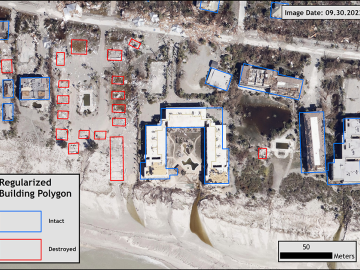
Filter News
Area of Research
- (-) National Security (38)
- (-) Supercomputing (107)
- Advanced Manufacturing (2)
- Biological Systems (1)
- Biology and Environment (97)
- Biology and Soft Matter (1)
- Computational Biology (1)
- Computational Engineering (1)
- Computer Science (4)
- Energy Science (58)
- Fusion and Fission (4)
- Isotopes (7)
- Materials (46)
- Materials for Computing (9)
- Neutron Science (32)
- Nuclear Science and Technology (3)
- Quantum information Science (4)
News Type
News Topics
- (-) Biomedical (12)
- (-) Computer Science (85)
- (-) Cybersecurity (21)
- (-) Environment (21)
- (-) Machine Learning (22)
- (-) Microscopy (7)
- (-) Summit (36)
- 3-D Printing/Advanced Manufacturing (7)
- Advanced Reactors (1)
- Artificial Intelligence (43)
- Big Data (19)
- Bioenergy (11)
- Biology (13)
- Biotechnology (3)
- Buildings (3)
- Chemical Sciences (4)
- Coronavirus (13)
- Energy Storage (6)
- Exascale Computing (23)
- Frontier (29)
- Fusion (1)
- Grid (8)
- High-Performance Computing (38)
- Isotopes (2)
- Materials (13)
- Materials Science (15)
- Mathematics (2)
- Molten Salt (1)
- Nanotechnology (10)
- National Security (35)
- Neutron Science (15)
- Nuclear Energy (6)
- Partnerships (5)
- Physics (9)
- Quantum Computing (16)
- Quantum Science (22)
- Security (14)
- Simulation (13)
- Software (1)
- Space Exploration (2)
- Transportation (6)
Media Contacts

A technology developed at ORNL and used by the U.S. Naval Information Warfare Systems Command, or NAVWAR, to test the capabilities of commercial security tools has been licensed to cybersecurity firm Penguin Mustache to create its Evasive.ai platform. The company was founded by the technology’s creator, former ORNL scientist Jared M. Smith, and his business partner, entrepreneur Brandon Bruce.
The Autonomous Systems group at ORNL is in high demand as it incorporates remote sensing into projects needing a bird’s-eye perspective.

Environmental scientists at ORNL have recently expanded collaborations with minority-serving institutions and historically Black colleges and universities across the nation to broaden the experiences and skills of student scientists while bringing fresh insights to the national lab’s missions.

U2opia Technology, a consortium of technology and administrative executives with extensive experience in both industry and defense, has exclusively licensed two technologies from ORNL that offer a new method for advanced cybersecurity monitoring in real time.

Although blockchain is best known for securing digital currency payments, researchers at the Department of Energy’s Oak Ridge National Laboratory are using it to track a different kind of exchange: It’s the first time blockchain has ever been used to validate communication among devices on the electric grid.

Having lived on three continents spanning the world’s four hemispheres, Philipe Ambrozio Dias understands the difficulties of moving to a new place.

Laboratory Director Thomas Zacharia presented five Director’s Awards during Saturday night's annual Awards Night event hosted by UT-Battelle, which manages ORNL for the Department of Energy.

Over the past seven years, researchers in ORNL’s Geospatial Science and Human Security Division have mapped and characterized all structures within the United States and its territories to aid FEMA in its response to disasters. This dataset provides a consistent, nationwide accounting of the buildings where people reside and work.

ORNL researchers are deploying their broad expertise in climate data and modeling to create science-based mitigation strategies for cities stressed by climate change as part of two U.S. Department of Energy Urban Integrated Field Laboratory projects.

Two years after ORNL provided a model of nearly every building in America, commercial partners are using the tool for tasks ranging from designing energy-efficient buildings and cities to linking energy efficiency to real estate value and risk.


